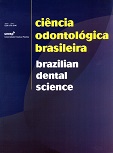Microleakage evaluation of resin composite restorations polymerized with different blue light-emitting diode units (LED)
DOI:
https://doi.org/10.14295/bds.2005.v8i2.381Abstract
The aim of this study was to evaluate the microleakage of class II resin composite restorations polymerized with light-emitting diodes (LEDs) with different numbers of blue diodes. One hundred sixty-eight class II cavities were prepared in bovine teeth. A one-bottle adhesive system (Single Bond/3M ESPE) was applied. The microhybrid or packable resin composites were inserted in three horizontal increments and cured for 40 seconds each, according to the following groups (n=21): G1- Z250 + LED light curing unit with 19 LEDs (3M ESPE); G2- Surefil + LED light curing unit with 19 LEDs; G3- Z250 + LED light curing unit with 7 LEDs (DMC); G4-Surefil + LED light curing unit with 7 LEDs; G5- Z250 + LED light curing unit with 6 LEDs (MM Optics); G6- Surefil + LED light curing unit with 6 LEDs; G7- Z250 + conventional halogen light curing unit (Demetron-Kerr); G8-Surefil + conventional halogen light curing unit. After thermocycling, the specimens were immersed in 2% methylene blue solution and then evaluated for microleakage. The Kruskal-Wallis and non-parametric Multiple Comparison tests (p<0.05) showed statistically significant differences among groups median: G1: 1(d); G2: 4(a); G3: 1(cd); G4: 4(a); G5: 2(bc); G6: 4(a); G7: 1(cd); G8: 4(ab). The blue light-emitting diode units (LEDs) demonstrated similar results to the conventional halogen lamp unit and the microleakage of the packable resin composite was significantly more severe than that of the microhybrid resin composite.Downloads
Downloads
Published
How to Cite
Issue
Section
License
Brazilian Dental Science uses the Creative Commons (CC-BY 4.0) license, thus preserving the integrity of articles in an open access environment. The journal allows the author to retain publishing rights without restrictions.
=================




























